Vietnamese Crispy Pork Belly, or Thịt Heo Quay, is a beloved staple in Vietnamese cuisine. Once reserved for special occasions, this decadent pork with its irresistibly crispy skin can now be enjoyed anytime, thanks to this easy-to-follow recipe!
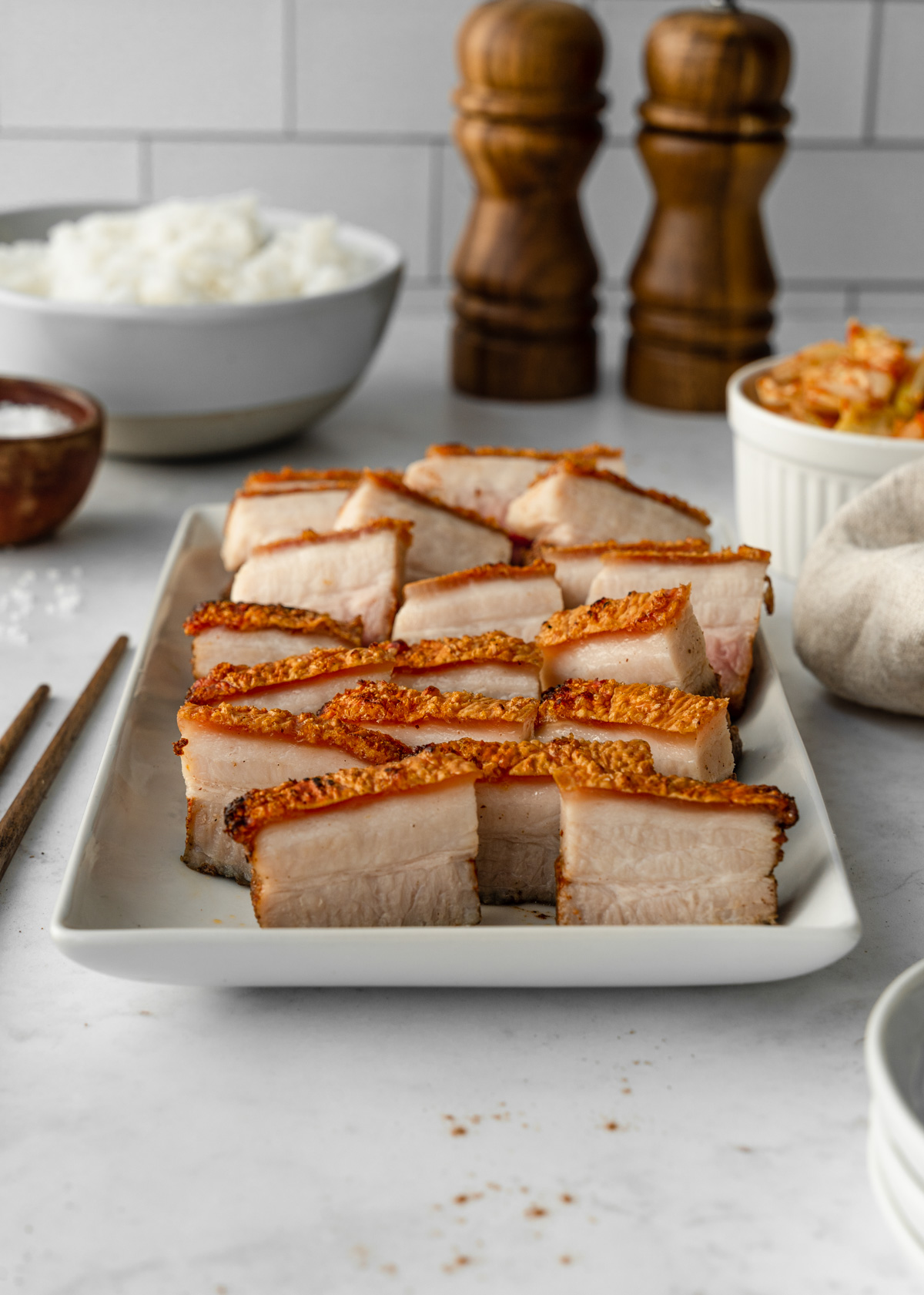
Jump to:
🥓 What Is Thịt Heo Quay?
In Vietnamese, thịt is "meat", heo translates to "pig", and quay is "roasted". So all together, thịt heo quay translates to "roasted pork". In this beloved dish, the roasted pork belly turns out incredibly juicy and tender, while the skin crisps and puffs up to form its signature crackling.
Back in the day, meat was a luxury in Vietnam, and large slabs of pork were nearly impossible to come by. That’s why Thịt Heo Quay was reserved for life’s most cherished celebrations—weddings, holidays, and, of course, Lunar New Year (Tết).
With roots tracing back to China, this crispy, succulent pork belly has become a star in Vietnamese cuisine. You’ll now find it proudly displayed at traditional Chinese-Vietnamese restaurants or sizzling away in BBQ take-out joints in Chinatown.
I can still remember the excitement when my parents brought home a pound or two after work, pairing it with traditional Viet dishes like Chayote Squash with Beef and crispy, golden Egg Rolls (Chả Giò). It was a feast that never failed to delight!
Why You'll Love It
- Mouth-watering: This crispy pork belly is wildly popular for a reason. It's full of flavor and texture - simply put, it's absolutely delicious.
- Versatile: Enjoy Vietnamese Crispy Pork Belly in a multitude of ways. Serve it in a bánh mi sandwich, with bánh hỏi or bún (vermicelli noodles), with cơm (rice), or simply on its own with Vietnamese Dipping Fish Sauce (Nước Chấm).
- Great for crowds: Nearly every Vietnamese celebration has Thịt Heo Quay on the menu! This recipe is great for serving a large gathering and both adults and kids are going to love it!
🧂 Ingredients
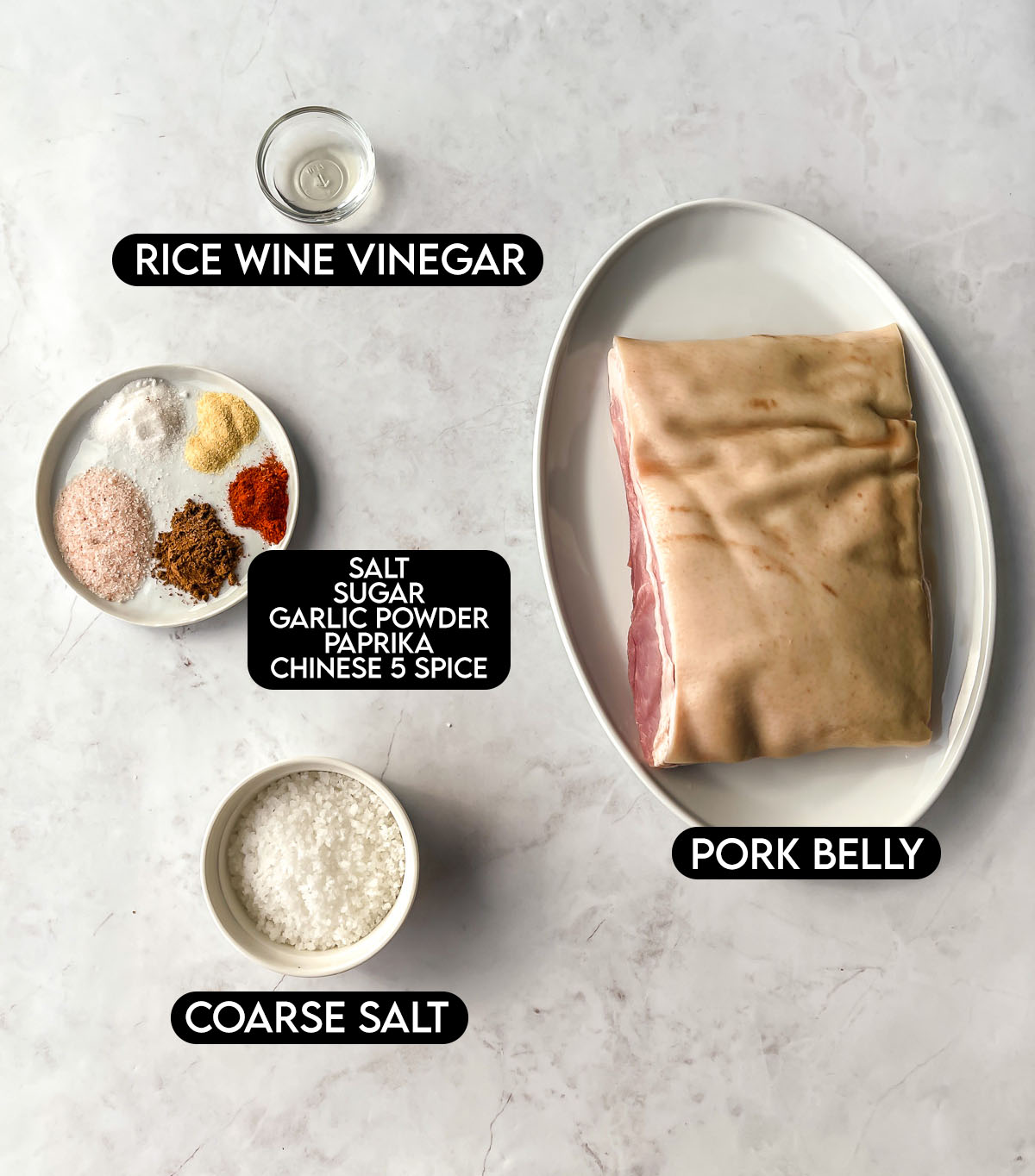
- Pork belly: You're going to need a singular, large rectangular slab of skin-on pork belly for this recipe. I recommend visiting an Asian market or specialty butcher shop. I often get a larger piece than the recipe calls for and cut the best portion down to size. Use the remainder for Xôi Khúc (Vietnamese Sticky Rice and Spinach Balls).
Tip: For best results, your pork belly should be flat (avoid wrinkles in the skin), as even in height as possible, and have more meat than fat.
- Rice wine vinegar: The acidity of the vinegar helps cut through the fat of the pork and tenderizes the skin. You could use Shaoxing wine instead.
- Salt: You'll need two types of salt for this recipe. Regular (fine) salt to season the meat and coarse salt to dry out the skin in the initial roast. Large rock or coarse salt is best so it's easy to remove and won't soak into the skin to make it too salty.
- Chinese five spice: A staple in Chinese and Vietnamese cooking. This spice blend features star anise, ground cloves, fennel, Szechuan peppercorn, and cinnamon for a warm and fragrant flavor.
- Paprika: Instead of making Thịt Heo Quay spicy, it adds smokiness and vibrant red color to the meat.
- Garlic powder: Fresh garlic cloves can burn quickly so I like to use garlic powder for oven roasted recipes like this salted crusted pork belly, Gochujang Salmon, and Bang Bang Brussels Sprouts.
- White granulated sugar: Just a touch to helps level out all of the flavors. It creates the perfect balance of savory, salty, and sweet.
- Cooking oil: A very sparse amount to help crisp up the skin during the final broil. Avocado oil is my favorite oil to cook, fry, and sauté with because of its high smoke point (500°F) and neutral flavor.
👩🏻🍳 How To Make Thịt Heo Quay
⬇️ Please scroll down to the recipe card to see full ingredient amounts and instructions.
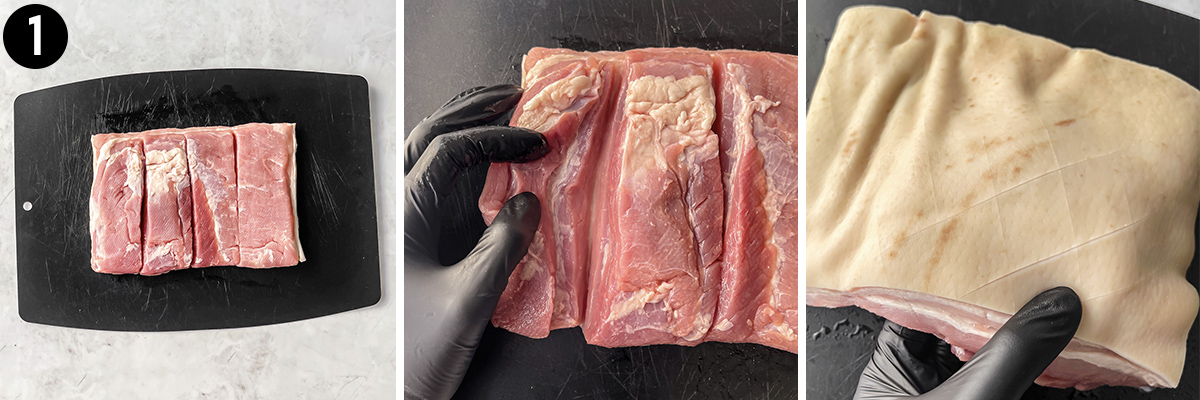
STEP ONE: First, prepare the seasonings. In a small bowl, whisk togethre rice wine vinegar and kosher salt. In a separate bowl, combine Chinese five spice, paprika, garlic powder, sugar, and salt. Set both aside.
Then prepare the pork. Rinse it with water, dry it thoroughly, and place it on a cutting board, meat side up. Cut 3-4 parallel lines halfway into the meat, avoiding the fat.
STEP TWO: Rub the dry seasoning mixture all over the meat.
Flip the pork belly so it's skin-side up and wipe it as dry as you can. If there are any stray hairs, use tweezers to remove as many as possible. If it grosses you out, my mom said they burn up in the oven anyway 🤷🏻♀️.
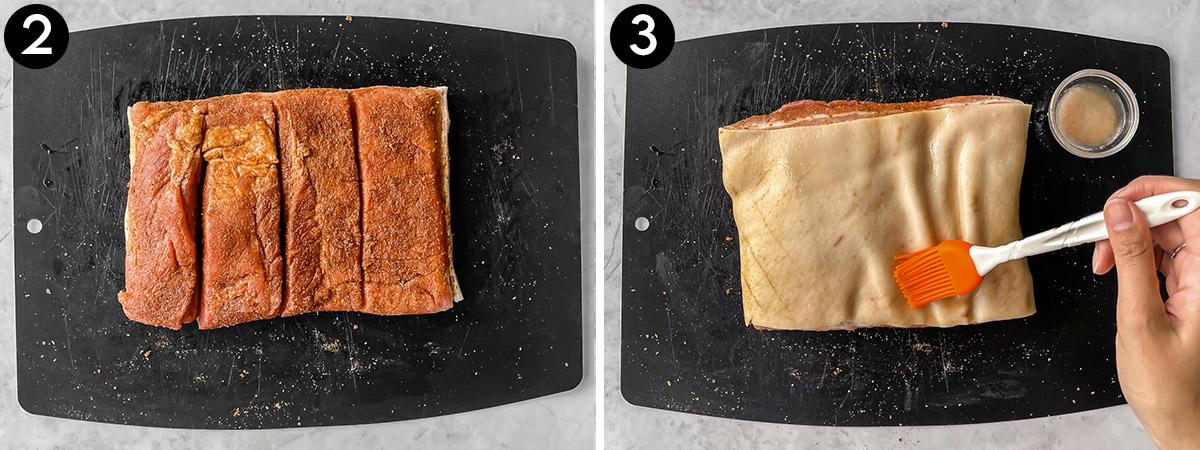
STEP THREE: Use a very sharp knife to "score" the skin. Start by making diagonal cuts in one direction all across the skin, then repeat in the other direction to create hash marks. You MUST avoid the fat! If you spread the skin apart, you should NOT see the white fat layer.
After the diagonal cuts, use your knife to poke holes all over the skin.

STEP FOUR: Then brush the vinegar mixture all over the skin.
STEP FIVE: Line a baking sheet with foil, then place a wire rack inside. Place the pork belly on top. Let sit in the refrigerator for 24-48 hours uncovered to dry out.

STEP SIX: The next day, preheat the oven to 350°F. The pork belly should look darker, matte, and dried out. Use a large piece of foil to wrap the meat tightly while leaving the skin exposed. Leave a border all around the top. If there are any areas of pork that is shorter than the rest, roll up balls of foil and place it underneath to make it as even in height as possible.
Use a sharp knife to poke holes all over the skin once more. Then cover the skin with a layer of coarse salt, making sure no skin is visible.
Roast for 1 hour.
STEP SEVEN: Take the pork belly out of the oven and turn on the broiler (500°F). Meanwhile, fold the foil down and remove all the salt off the pork onto the foil. Discard both. The pork should be directly on the wire rack.
Lightly brush the skin with a tiny amount of oil. Place it back into the oven and broil for 5-10 minutes. Keep an eye on it and rotate as needed. If any areas are burning, cover with foil. Then let Vietnamese Crispy Pork Belly rest for minimum 10 minutes before slicing.
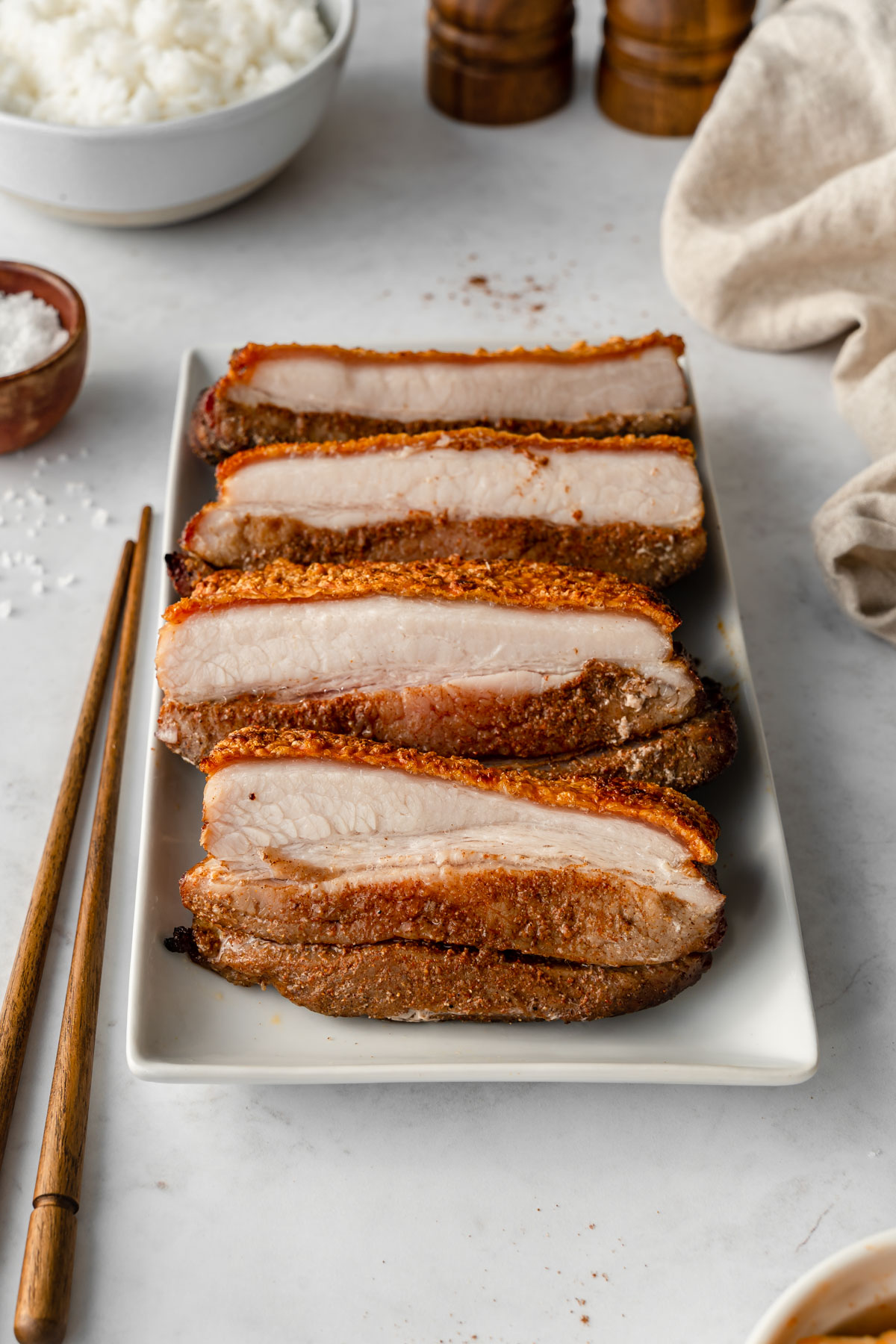
💭 Top Tips
- Plan ahead: It’s important to plan ahead to allow your pork belly to dry brine for at least 24 hours. This is crucial to creating a tender, juicy center and crisp, bubbly skin for the perfect Thịt Heo Quay.
- Use a sharp knife: Pork skin is tough and rubbery. For even and precise cuts, make sure to use a sharp knife or else you'll risk cutting into the fat. You could also use special tools like an ice pick, sharp metal skewer, jaccard, or meat thermometer - but a sharp knife will be best.
- Avoid the fat: Be mindful of how deep you’re cutting into the skin! You’ll want to make sure the cuts are very shallow. If you slice into the fat (white and soft layer), it'll melt during the roast, bubble over onto the skin, and prevent it from getting crispy.
- Even in height: Use foil, vegetables, a wire rack, or any oven-safe item you have on hand to place underneath shorter areas of pork. This ensures that it'll cook evenly.
- Let it rest: After cooking, Thịt Heo Quay will be extremely hot! Do not be tempted to cut into it yet. Let it rest for minimum 10-15 minutes, but I recommend letting it cool to room temperature. This allows the juices to redistribute throughout the meat, making it extra tender and juicy.
What To Serve With Vietnamese Crispy Pork Belly
- Đồ chua: Pickled vegetables are a very traditional pairing with Vietnamese Crispy Pork Belly. You could do pickled carrots and daikon, but pickled leeks (my parents' favorite) or kimchi also works.
- Noodles: Serve Thịt Heo Quay with vermicelli noodles (bún), lettuce, fresh herbs, pickled vegetables, and Vietnamese Dipping Fish Sauce (Nước Chấm). Bánh hỏi (vermicelli noodle woven packs) is also very traditional in northern Vietnam.
- Banh mi: Popularized by the banh mi store Carrot and Daikon, banh mi thịt heo quay is super trendy right now! Recreate it at home by stuffing Vietnamese Crispy Pork Belly into a fluffy baguette with pate, mayo, Maggi, pickled vegetables, cilantro, cucumber, and jalapeno.
- Simple: Enjoy Thịt Heo Quay with rice, wrapped in lettuce, or by itself for a protein-packed snack. If you'd like, dip it in some Nước Chấm sauce for a boost of flavor.

🥡 Storing & Freezing
Storing: Once cooled, you can store leftover Thịt Heo Quay in an airtight container in the fridge for up to 5 days.
Freezing: I don’t recommend freezing roasted Vietnamese Crispy Pork Belly as it’s likely to lose its crispy texture and become slightly soggy once thawed.
Reheating: When you’re ready to enjoy, reheat slices of pork in the toaster oven or air fryer at 325°F for 4-6 minutes or until warm.
📖 Recipe FAQs
The ultimate reason why pork belly does not come out crispy is because the skin is not dry. Dry brining for a minimum of 24 hours and a layer of salt on top are key to drying out the skin. Also, if your meat is uneven in height, the shorter areas will not be able to crisp as quickly as the taller areas.
The acidity of the vinegar helps the skin dry out and cuts through some of the heaviness of the fat, creating crispy skin and a well-balanced flavor.
This Asian crispy pork belly has a unique combination of tastes and textures. It features a crisp, crunchy layer of skin that is followed by a juicy layer of fat that leads to tender meat underneath. Both savory and sweet thanks to the use of warm spices and a pinch of sugar, the flavor is robust and unbelievably satisfying to the tastebuds.
Crispy pork belly, known as Thịt Heo Quay in Vietnamese cuisine, originates from Chinese culinary traditions, where it's called Siu Yuk (燒肉). This dish has been a staple in Cantonese cuisine for centuries, renowned for its crispy skin and tender meat. The technique of roasting pork belly spread to Vietnam, where it became a beloved dish often reserved for special occasions. Vietnamese versions of the dish incorporate local spices, giving it a unique flavor. Today, crispy pork belly is enjoyed across various Asian cultures, each with its own twist on the classic recipe.
🍽 Looking For More Vietnamese Recipes?
Love this recipe? Please leave a 5-star 🌟🌟🌟🌟🌟 rating in the recipe card below and consider leaving a comment. It's always greatly appreciated!
📋 Recipe

Vietnamese Crispy Pork Belly (Thit Heo Quay)
Equipment
Ingredients
- ½ tablespoon rice wine vinegar
- Kosher salt Diamond Crystal
- ½ teaspoon Chinese five spice
- ½ teaspoon paprika
- ½ teaspoon garlic powder
- 1 teaspoon white granulated sugar
- 2-2¼ lb pork belly slab with skin (see notes)
- ½ cup coarse salt (see notes)
- ½ teaspoon cooking oil
Instructions
- Season the pork. Set up two small bowls. In the first bowl, whisk together rice wine vinegar and 2 teaspoon kosher salt. In the second bowl, combine Chinese five spice, paprika, garlic powder, sugar, and 1 teaspoon kosher salt. Set both aside.
- Thoroughly rinse and dry the pork belly as much as possible. Cut 3-4 parallel lines, 1½-2 inches apart, into the meat - make sure you DON'T cut into the fat. Rub the Chinese five spice mixture all over the meat portion, into the cut exposed meat and onto the sides of the meat as well.
- Prepare the skin. Then flip the pork belly over so it's skin side up. This is the most important part. Wipe the skin very dry and use a sharp knife to cut very shallow parallel lines about ½ inch apart. Rotate the pork to cut perpendicular lines, creating a crisscross pattern on the skin. Make sure you do not cut into the fat as much as possible. Then use the same knife to poke holes all over the skin.
- Use a brush or spoon to pour the vinegar/salt mixture over the skin. Spread evenly all over.
- Dry brine. Line a baking sheet with foil and place a metal wire rack inside. Place the pork belly on top of the wire rack, skin side up. Let sit in the fridge uncovered for 24-48 hours. Afterwards, the skin should look dark and matte.
- The next day: Preheat the oven to 350°F. Use a large piece of foil to wrap the meat tightly with foil while leaving the skin exposed on top, like a boat. Leave a ½ inch border of foil all around on top. If your pork belly is uneven in height, place additional foil balls under the shorter areas to make the pork as even in height as possible.
- Use a sharp knife to poke more holes into the skin, focusing on areas that are not as dark or dry. Pour the coarse salt onto the skin and pat evenly so no skin in visible.
- Roast in the oven for 1 hour.
- Take the baking sheet out of the oven and turn on the broiler. Carefully unfold the foil and completely brush all of the coarse salt off. Discard both the salt and foil. Then lightly brush the skin with oil and place pork belly back onto the wire rack.
- Broil for 5-10 minutes until pork is crispy and puffy with golden bubbles on top, rotating as needed. If any areas start to char, carefully cover with foil. Let pork rest at least 10-15 minutes before slicing.
Notes
- Pork belly: Thit Heo Quay uses skin-on pork belly that is sold in a large singular slab. Although you may be able to find it at your local grocery store, your best bet is to visit an Asian grocery store or specialty butcher shop. Also, try to find pork belly that’s as even in height as possible and has the same thickness of meat, fat, and skin. This will allow for even cooking. Otherwise, some parts of the pork are likely to burn while others will remain rubbery.
- Salt: You'll need two types of salt for this recipe. Regular (fine) kosher or pink salt to season the meat and coarse salt to dry out the skin in the initial roast. Large rock or coarse salt is best so it's easy to remove and won't soak into the skin to make it too salty.
- Pork skin is tough and rubbery. For even and precise cuts, make sure to use a sharp knife or else you'll risk cutting into the fat. You could also use special tools like an ice pick, sharp metal skewer, or sewing needle - but a sharp knife will be best.
- There can be quite a lot of fat sizzling while the pork bakes. So, be sure to turn on the fans, keep it well-ventilated, and be extra careful when turning it around or removing it from the oven!
Nutrition
Recipe by Jessica (Balance with Jess) | Photography by Sharon Nge











Comments
No Comments